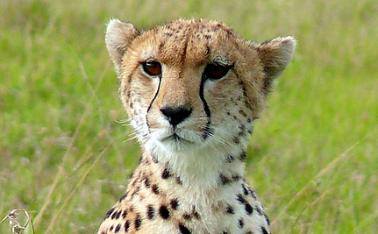 As reported in the Guardian, the National Museums of Kenya (NMK) and the Kenya Wildlife Service say that warmer temperatures due to climate change have led to cheetahs developing extra coils in their sperm, with adverse effects on their reproductive ability. In addition, warmer temperatures are influencing the animals’ eating habits. According to the Kenya Wildlife Service, there were more than 5,000 cheetahs in the country in the early 1980s but there are now only about 1,000. Risky Agwanda, head of mammology section at NMK, tells the Guardian that climate change has “contributed to defects” of the sperm of cheetahs, many of whom already have “abnormal coils, low sperm counts, as well as extremely low testosterone levels”; a study by the International Union for the Conservation of Nature also describes the cheetah as genetically impoverished. Other big cats, says Ahwanda, have able to adapt more readily to climate change and have not faced the reproductive difficulties of cheetahs. The African Wildlife Foundation says that cheetah cubs have a high rate of mortality, with 50 to 75 percent of them dying before 3 months due to being highly susceptible to disease at that age. Also of concern is that the population of the cheetah’s prey, Thomson’s gazelle, has been declining, also due to climate change, drought and human activities. Agwanda says that Thomson’s gazelle have a “very high protein content compared to other herbivores” and have therefore been favored by cheetahs. The gazelles have been crossbreeding with other species, which has lessened their protein content. Cheetahs have also had to prey on zebras which Agwanda describes as not having as high a nutritional value. Besides the challenges from a changing climate, cheetahs are also being killed by poachers for their fur. The cheetah can be called a biomechanical wonder, able to accelerate from speeds of zero to 70 mph in three seconds. But, tragically, it seems that these beautiful animals cannot run fast enough to save themselves from potentially disappearing from the face of the earth. From http://Care2.com
As reported in the Guardian, the National Museums of Kenya (NMK) and the Kenya Wildlife Service say that warmer temperatures due to climate change have led to cheetahs developing extra coils in their sperm, with adverse effects on their reproductive ability. In addition, warmer temperatures are influencing the animals’ eating habits. According to the Kenya Wildlife Service, there were more than 5,000 cheetahs in the country in the early 1980s but there are now only about 1,000. Risky Agwanda, head of mammology section at NMK, tells the Guardian that climate change has “contributed to defects” of the sperm of cheetahs, many of whom already have “abnormal coils, low sperm counts, as well as extremely low testosterone levels”; a study by the International Union for the Conservation of Nature also describes the cheetah as genetically impoverished. Other big cats, says Ahwanda, have able to adapt more readily to climate change and have not faced the reproductive difficulties of cheetahs. The African Wildlife Foundation says that cheetah cubs have a high rate of mortality, with 50 to 75 percent of them dying before 3 months due to being highly susceptible to disease at that age. Also of concern is that the population of the cheetah’s prey, Thomson’s gazelle, has been declining, also due to climate change, drought and human activities. Agwanda says that Thomson’s gazelle have a “very high protein content compared to other herbivores” and have therefore been favored by cheetahs. The gazelles have been crossbreeding with other species, which has lessened their protein content. Cheetahs have also had to prey on zebras which Agwanda describes as not having as high a nutritional value. Besides the challenges from a changing climate, cheetahs are also being killed by poachers for their fur. The cheetah can be called a biomechanical wonder, able to accelerate from speeds of zero to 70 mph in three seconds. But, tragically, it seems that these beautiful animals cannot run fast enough to save themselves from potentially disappearing from the face of the earth. From http://Care2.com
Climate Change is Endangering the Cheetah’s Ability to Reproduce

